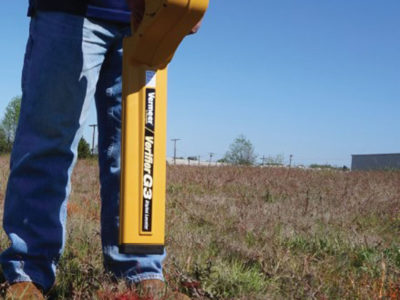Knowing where utilities are located on the jobsite is integral to a job well done. But to do that, you have to know how to operate your utility locator to stay efficient and correctly assess where utility lines are on the jobsite. Before you use a utility locator, an important (and sometimes required) step to take is to call 811. All you have to do is call the national phone number and inform the operator where you intend to dig. That information is then routed to the local One Call center, and utility companies will typically send technicians out to mark underground utilities within a couple days.
Even if a technician comes out and marks the underground utilities, using a utility locator can help locate the utility before exposing the utility line.
“These types of locators find the utility by picking up a signal from metallic pipes or a tracer wire,” explained Timothy Vande Noord, a Vermeer HDD training specialist. “If the utility line doesn’t have a tracer wire and is a plastic line, a utility locator won’t be able to find it.”
Missed and mislocated utilities are a tremendous concern for everyone. There are significant costs and safety concerns involved when strikes occur. According to the Common Ground Alliance 2019 DIRT Annual Report, there were 456,290 utility strikes and near misses reported in the U.S. and Canada. The fourth cause of these utility strikes is due to locating issues, where the utility line was inaccurately located or wasn’t marked correctly. Other times, the locator’s signal may be interfered with from other active utilities.
“Remember that while a locator is a great way to identify utility lines, it doesn’t take the place of actually exposing the utility and knowing its exact location,” said Vande Noord. “Make sure that you expose the utility using soft excavation (hand digging, vacuum excavator, etc.) before you start work on the utility.”
To help avoid utility strikes and near misses, you can find utility lines quickly and effectively with the Vermeer Verifier® G3 utility locator. One of the key steps to this process is to properly insert the ground stake near the utility location. You want to make sure you place it as far as possible and at a right angle to the object line. When you do that, you also want to keep the receiver at least 16 ft (5 m) away from the signal connection point. Other steps, including verifying the transmitters match and picking the right locate mode for your application, are essential to make sure you’re using your utility locator correctly. To learn more about the process, watch the video below.
Vermeer Corporation reserves the right to make changes in engineering, design and specifications; add improvements; or discontinue manufacturing at any time without notice or obligation. Equipment shown is for illustrative purposes only and may display optional accessories or components specific to their global region. Please contact your local Vermeer dealer for more information on machine specifications.
Vermeer, the Vermeer logo and Verifier are trademarks of Vermeer Manufacturing Company in the U.S. and/or other countries. © 2021 Vermeer Corporation. All Rights Reserved.
